Author: The Editors
Books from Finland to take archive form
22 May 2015 | In the news
The following is a press release from the Finnish Literature Society.
The Finnish Literature Society is to cease publication of the online journal Books from Finland with effect 1 July 2015 and will focus on making material which has been gathered over almost 50 years more widely available to readers.
Books from Finland, which presents Finnish literature in English, has appeared since 1967. Until 2008 the journal appeared four times a year in a paper version, and subsequently as a web publication. Over the decades Books from Finland has featured thousands of Finnish books, different literary genres and contemporary writers as well as classics. Its significance as a showcase for our literature has been important.
The major task of recent years has been the digitisation of past issues of the journal to form an electronic archive. The archive will continue to serve all interested readers at www.booksfromfinland.fi; it is freely available and may be found on the FILI website (www.finlit.fi/fili).
Much is written in English and other languages about Finnish literature: reviews, interviews and features appear in even the biggest international publications. The need for the presentation of our literature has changed. Among the ways in which FILI continues to develop its remit is to focus communications on international professionals in the book field, on publishers and on agents.
The reasons for ceasing publication of Books from Finland are also economic. Government aid to the Finnish literature information centre FILI, which has functioned as the journal’s home, has been cut by ten per cent.
Books from Finland was published by Helsinki University Library from 1967 to 2002, when the Finnish Literature Society took on the role of publisher. FILI has been the body within the Finnish Literature Society that has been responsible for the journal’s administration, and it is from FILI’s budget that the journal’s expeses have been paid.
Enquiries: Tuomas M.S. Lehtonen, Secretary General of the Finnish Literature Society, telephone +358 40 560 9879.
In memoriam Austin Flint (1931–2015)
2 April 2015 | In the news
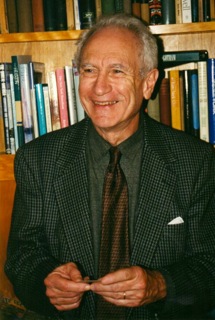
Austin Flint
The playwright, teacher and translator Austin Flint died in New York on 1 February.
Austin was Adjunct Professor in the Department of Arts at Columbia University, New York, and taught playwriting there for almost half a century. Among the translations from Finnish into English he made – together with his wife Aili Flint – are the novel The Parson’s Widow (Hänen olivat linnut) by Marja-Liisa Vartio and the play Anna-Liisa by Minna Canth.
Austin’s plays include: The Flaming Spider: Jonathan Edwards in Northhampton, Prison Light, Marching to Jubilee: William Lloyd Garrison’s Campaign for the Abolition of Slavery and Compartments. His work has been performed in New York and at Yale University.
Austin Flint was a member of the Editorial Advisory Board of Books from Finland from 1985 to 1995. With Aili – whom he met in 1958 in Helsinki, where he was teaching – he translated many articles and extracts for the journal.
The Flints acted as hosts in 1986 when the Editorial Board of Books from Finland visited New York to discuss the development of the journal with them and a few selected literary figures. The Editorial Board found Austin’s expertise and interest in making Finnish literature better known in the United States most useful and encouraging. We remember Austin as a warm-hearted collaborator whose gentle humour greatly enlivened the editorial process.
Fiat Lux!
31 December 2014 | This 'n' that
 Time for Lux Helsinki light event again: the January 2014 festival (see photos here) brought 150,000 visitors from Helsinki, the rest of Finland and around the world to the city. It is organised by the City of Helsinki.
Time for Lux Helsinki light event again: the January 2014 festival (see photos here) brought 150,000 visitors from Helsinki, the rest of Finland and around the world to the city. It is organised by the City of Helsinki.
The artworks – 17 of them – will be on display in 13 places around the centre of Helsinki, from the courtyard of the Tori Quarters to Finlandia Hall. The light and media artists and sound designers come from Finland, Germany, France, Belgium and Japan.
Lux Helsinki is also part of as the International Year of Light and Light-based Technologies of the United Nations in 2015.
Darkness will slowly diminish, and there will be more light: it’s great that Helsinki winter – at times white with snow, at times not – will again (thanks to artists and the latest technology) be filled with colour for a while. Let light be made!
To write, to draw
18 December 2014 | This 'n' that
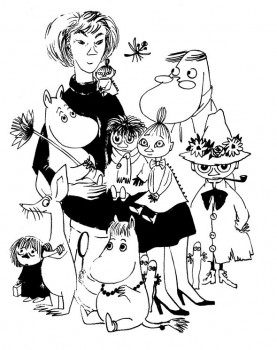
Self-portrait: Tove Jansson with her creations. Picture: @Moomin Characters™
A new Finnish biography of Tove Jansson (1914–2001) was published in 2013; the artist and creator of the Moomins has been celebrated in 2014 in her centenary year. Tove Jansson. Tee tytötä ja rakasta by Tuula Karjalainen was published in English this autumn, translated by David McDuff, under the title Tove Jansson: Work and Love (Penguin Global, Particular Books).
The book was reviewed by The Economist newspaper on 22 November. Unsurprisingly, according to the review, Jansson was more interesting as a writer than as a painter:
’Jansson always saw herself first as a serious painter. She exhibited frequently in Finland, and won awards and commissions for large public murals. Her reputation there as a writer lagged far behind the rest of the world. Ms Karjalainen is a historian of Finnish art, and although she covers Jansson’s writing, it is the paintings that really interest her. This is a pity. Jansson was a more interesting writer than a painter, and her life sheds much light on her particular quality as a storyteller.’
Whereas Karjalainen concentrates on Jansson’s painting, another biography of Jansson, by the Swedish literary scholar Boel Westin (reviewed here) focuses on Jansson as a writer. Here, you can find a selection of Tove Jansson’s art.
A quotation from The Economist‘s review: ‘Her use of Moomins to defy the war is characteristic. Everywhere in her fiction there is the same sense of deflection and indirection. She hated ideologies, messages, answers. And it somehow fits that she fell in love with both men and women. Ambivalence was a kind of comfort to her. As one of her characters says, “Everything is very uncertain, and that is what makes me calm.’
Tove Jansson’s versatile brilliance as an artist, we think, is at its best in the way she combined illustration and text in her Moomin stories. Their (great) visual and philosophical value lies in the praise of freedom and independence of the mind: for everyone, young or old.
Archives open!
12 December 2014 | This 'n' that
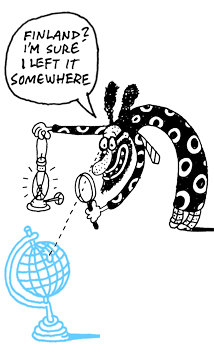
Illustration: Hannu Konttinen
For 41 years, from 1967 to 2008, Books from Finland was a printed journal. In 1976, after a decade of existence as not much more than a pamphlet, it began to expand: with more editorial staff and more pages, hundreds of Finnish books and authors were featured in the following decades.
Those texts remain archive treasures.
In 1998 Books from Finland went online, partially: we set up a website of our own, offering a few samples of text from each printed issue. In January 2009 Books from Finland became an online journal in its entirety, now accessible to everyone.
We then decided that we would digitise material from the printed volumes of 1976 to 2008: samples of fiction and related interviews, reviews, and articles should become part of the new website.
The process took a couple of years – thank you, diligent Finnish Literature Exchange (FILI) interns (and Johanna Sillanpää) : Claire Saint-Germain, Bruna di Pastena, Merethe Kristiansen, Franziska Fiebig, Saara Wille and Claire Dickenson! – and now it’s time to start publishing the results. We’re going to do so volume by volume, going backwards.
The first to go online was the fiction published in 2008: among the authors are the poets Tomi Kontio and Rakel Liehu and prose writers Helvi Hämäläinen (1907–1998), Sirpa Kähkönen, Maritta Lintunen, Arne Nevanlinna, Hagar Olsson (1893–1979), Juhani Peltonen (1941–1998) and Mika Waltari (1908–1979).
To introduce these new texts, we will feature a box on our website, entitled New from the archives, where links will take you to the new material. The digitised texts work in the same way as the rest of the posts, using the website’s search engine (although for technical reasons we have been unable to include all the original pictures).
![]()
By the time we reach the year 1976, there will be texts by more than 400 fiction authors on our website. We are proud and delighted that the printed treasures of past decades – the best of the Finnish literature published over the period – will be available to all readers of Books from Finland.
The small world of Finnish fiction will be even more accessible to the great English-speaking universe. Read on!
Encounters with a language
12 December 2014 | Articles, Non-fiction
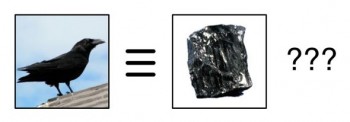
Mistranslation: illustration by Sminthopsis84/Wikimedia
Mother tongue: not Finnish. How do people become interested enough in the Finnish language in order to become translators? In the olden days some might have been greatly inspired by the music Sibelius (as were the eminent British translators of Finnish, David Barrett or Herbert Lomas, for example, back in the 1950s and 1960s). We asked contemporary translators to reminisce on how they in turn have become infatuated enough with Finnish to start studying and translating this small, somewhat eccentric northern language. Three translators into English, one into French, German and Latvian tell us why
And the winner is… Finlandia Prize for Fiction 2014
27 November 2014 | In the news
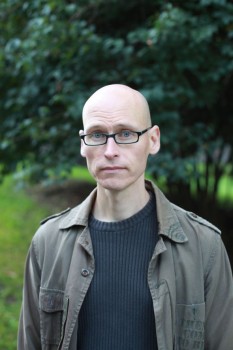
Jussi Valtonen. Photo: Markko Taina
The winner of the prize this year, worth €30,000 and awarded on 27 November, is He eivät tiedä mitä he tekevät (‘For they know not what they do’, Tammi) by Jussi Valtonen (born 1974), a psychologist and writer. The novel – 558 pages – is his third: it focuses on the relationship of science and ethics in the contemporary world, with an American professor of neuroscience, married to a Finn, as the protagonist.
Professor Anne Brunila – who has worked, among other posts, as a CEO in forest and energy industry – chose the winner. In her awarding speech she said: ‘The novel is an astonishing combination of perceptive description of human relationships, profound moral and ethical reasoning, science fiction and suspense…. I have never encountered a Finnish portrayal of our present era that is anything like it.’
The other five novels on the shortlist of six were the following:
Kaksi viatonta päivää (‘Two innocent days’, Gummerus) by Heidi Jaatinen is a story of a child whose parents are not able to take care of her; Olli Jalonen’s Miehiä ja ihmisiä (’Men and human beings’, Otava) focuses on a young man’s summer in the 1970s. Neljäntienristeys (‘The crossing of four roads’, WSOY), a first novel by Tommi Kinnunen, is a story set in the 20th-century Finnish countryside over three generations. Kultarinta (‘Goldbreast’, Gummerus) by Anni Kytömäki is a first novel about generations, set in the years between 1903 and 1937, celebrating the Finnish forest and untouched nature. Graniittimies (‘Granite man’, Otava) by Sirpa Kähkönen portrays a young, idealistic Finnish couple who move to the newly-founded Soviet Union to work in the utopia they believe in.
A long list of good novels
27 November 2014 | In the news
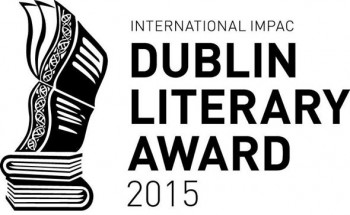 The longlist for the International IMPAC Dublin Literary Award 2015 has been announced and, among the 142 translated novels – from 39 countries and 16 original languages – are two from Finland.
The longlist for the International IMPAC Dublin Literary Award 2015 has been announced and, among the 142 translated novels – from 39 countries and 16 original languages – are two from Finland.
Mr Darwin’s Gardener by Kristina Carlson (Peirene Press, UK, 2012), a novel set in the 1860s England, is translated by Emily and Fleur Jeremiah (see the extracts in Books from Finland).
Cold Courage, a thriller by Pekka Hiltunen (Hesperus Press, UK), is translated by Owen Witesman. Both entries were nominated by Helsinki City Library.
Among the authors writing in English are Margaret Atwood, J.M. Coetzee, Roddy Doyle, Stephen King, Jhumpa Lahiri, Thomas Pynchon and Donna Tartt.
This literary award was established by Dublin City, Civic Charter in 1994. Nominations are made by libraries in capital and major cities throughout the world, on the basis of ‘high literary merit’. In order to be eligible for consideration in 2015 a novel translated into English must be first published in the original language between 1 January 2009 and 31 December 2013.
The award for a translated novel is worth €75,000 to the author, €25,000 to the translator. The shortlist of ten titles will be announced by an international panel of judges in April 2015, the winner in June.
We’ll be keeping our fingers crossed for our ex-Editor-in-Chief Kristina Carlson!
‘The Lion of the North’ wins the non-fiction Finlandia Prize
25 November 2014 | In the news
The Finlandia Prize for Non-Fiction 2014, worth €30,000 and awarded by Suomen Kirjasäätiö (The Finnish Book Foundation), went to the historian and author Mirkka Lappalainen on 19 November for her book on a 17th-century Swedish king.
Finlandia Prize for Non-Fiction 2014, worth €30,000 and awarded by Suomen Kirjasäätiö (The Finnish Book Foundation), went to the historian and author Mirkka Lappalainen on 19 November for her book on a 17th-century Swedish king.
The winning entry, entitled Pohjolan leijona, Kustaa II Adolf ja Suomi 1611–1632 (‘The Lion of the North. Gustavus II Adolphus and Finland 1611–1632’, Siltala), was chosen by from a shortlist of six finalists by Heikki Hellman, journalist and Dean of the School of Communication, Media and Theatre in Tampere. According to him, ‘Pohjolan leijona is an exceptionally well-written narrative for a non-fiction book; the author uses both earlier literature and numerous primary and secondary sources with great skill. Lappalainen succeeds in demonstrating how, during the reign of Gustavus II Adolphus, both Sweden and its easterly province, Finland, began to develop an organised society with its structure of officials and bureaucracy, how jurisdiction replaced the arbitrary rule of the aristocracy and how it was only then that Finland developed its role as part of Sweden. Pohjolan leijona sweeps the reader along and helps us to understand where we have come from and who we are.’
Hellman also commented on the growing practice of publishing non-fiction texts in English only: ‘Research is not done only for other scholars; it must also be relevant to people’s lives and be brought to their attention. We must also publish in our mother tongue, or else it will not survive as a language for research. This is one of the reasons why non-fiction is so necessary.’
Mirkka Lappalainen has received other prizes for her work. Susimessu (‘Wolf mass’), for example, was voted History Book of the year in 2010.
Angry epic heroes?
20 November 2014 | This 'n' that
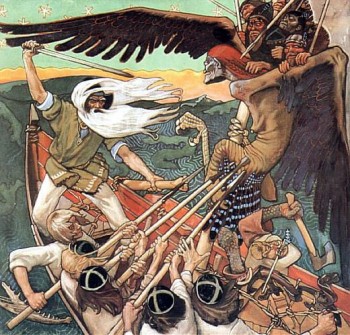
Action man: Väinämöinen fights the Hag of the North. Painting by Akseli Gallen-Kallela, 1896 (Turku Art Museum). Wikipedia
The Finnish national epic, the Kalevala, is the inspiration for a grand-scale film trilogy project. It involves employees of several entertainment media companies working on it in their free time. The Finnish entertainment media company Rovio that became famous for its Angry Birds game, and the Finnish-born video game company Supercell have sponsored – with other 13 media companies – the trailer: see IronDanger.
Financing is still in the planning stages, but it is hoped that the first part will be ready in 2017 when Finland celebrates its centenary year.
According to Rovio’s Chief Marketing Officer, Peter Vesterbacka, the film will be ‘adequately’ faithful to the original work. In an interview published on 19 November on the website of the Finnish Broadcasting Company YLE, he says that even if the landscape will look very Finnish, the intention is to ’tell the story to make it clear that it’s not about a bunch of old pensioners. These are young, heroic, epic heroes‘.
So, vaka vanha Väinämöinen – ‘Väinämöinen, old and steadfast’ – , the main character of the epic, the great shaman and the bard, the tragic hero, is to be kicked off the cast, because he’s, well, elderly?
Funny that the bearded wizard Gandalf of Lord of the Rings was not dismissed from the film due to his age, even though he does indeed looks as old as the hills of Gondor. (By the way, Väinämöinen has been ‘identified as a source for Gandalf’…)
It remains to be seen how the younger Kalevala crowd will deal with all that action. Who, for example, is going to sink the impetuous Joukahainen into a bog by singing, then?
The Finlandia Junior Prize 2014
20 November 2014 | In the news
 Maria Turtschaninoff’s third fantasy book for young people, Maresi. Krönikor från röda klostret / Maresi. Punaisen luostarin kronikoita (‘Maresi. Chronicles of the Red Convent’, Schildts & Söderströms; Finnish translation by Marja Kyrö, publisher Tammi) was awarded the Finlandia Junior Prize, worth €30,000, on 20 November.
Maria Turtschaninoff’s third fantasy book for young people, Maresi. Krönikor från röda klostret / Maresi. Punaisen luostarin kronikoita (‘Maresi. Chronicles of the Red Convent’, Schildts & Söderströms; Finnish translation by Marja Kyrö, publisher Tammi) was awarded the Finlandia Junior Prize, worth €30,000, on 20 November.
The winner was chosen by the scriptwriter and film director Johanna Vuoksenmaa who, in her awarding speech, said that it is ‘an exceptionally powerful fantasy book which, in addition to telling an exquisite, wise and exciting story, also provides a welcome correction to the gender division of fantasy book characters, which has been slightly skewed ever since Tolkien. Maresi reminds me that even today there are places in the world where readers are not sought for books, where knowledge is not on offer to young, thirsty minds. People’s opportunities to know and learn are limited and human rights trampled upon.’
The other five candidates were the following:
Written and illustrated by Saku Heinänen, Zaida ja lumienkeli (‘Zaida and the snow angel’, Tammi) is the story of a little girl whose school days are not always happy; Puiden tarinoita. Puuseppä (‘Stories by trees. The carpenter’, Books North) is a fairy-tale written by Iiro Küttner and illustrated by the graphic artist and cartoonist Ville Tietäväinen; Jyri Paretskoi’s first novel Shell’s Angles ja Kalajoen hiekat (‘Shell’s Angles and the Kalajoki sands’, Karisto) is a humorous story for young teenagers; Min egen lilla liten / Oma pieni pikkuruinen (‘My own tiny little thing’, Schildts & Söderströms, Teos) is a picture story about longing for closeness told by Ulf Stark and illustrated by Linda Bondestam; a picture book about a little squirrel by Mila Teräs, Olga Orava ja metsän salaisuus (‘Olga Squirrel an the forest’s secret’, Lasten Keskus) is illustrated by Karoliina Pertamo.
Prize for the best debut book
20 November 2014 | In the news
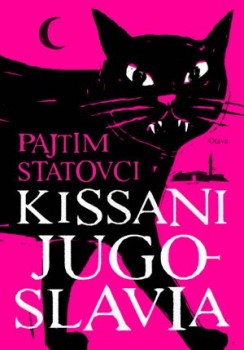 The Helsingin Sanomat literature prize for the best first work, written in Finnish, for 2014 was awarded on 13 November to Kosovo-born Pajtim Statovci, 24, for his novel Kissani Jugoslavia (‘Yugoslavia my cat’, Otava – see translated extracts here).
The Helsingin Sanomat literature prize for the best first work, written in Finnish, for 2014 was awarded on 13 November to Kosovo-born Pajtim Statovci, 24, for his novel Kissani Jugoslavia (‘Yugoslavia my cat’, Otava – see translated extracts here).
The choice was made by a five-strong jury from a total of 65 books. The prize, which was this year awarded for the 20th time, is worth €15,000.
Among the ten finalists were a collection of essays, three collections of poetry and six novels. According to the jury, Statovci’s novel, ‘drowns the reader, after a realistic description of events, in a dreamlike, lyrical vision. This kind of writing is not taught anywhere. The skill either resides in the writer or it doesn’t.’
Shortlist for Finlandia Prize for Non-Fiction 2014
13 November 2014 | In the news
 The shortlist for the Finlandia Prize for Non-Fiction 2014 – worth €30,000 – was announced on 5 November by the chairperson of the jury, Susanna Pettersson, Director of the Ateneum Art Museum. The works on the list of six are as follows:
The shortlist for the Finlandia Prize for Non-Fiction 2014 – worth €30,000 – was announced on 5 November by the chairperson of the jury, Susanna Pettersson, Director of the Ateneum Art Museum. The works on the list of six are as follows:
Pohjolan leijona, Kustaa II Adolf ja Suomi 1611–1632 (‘The lion of the North. Gustavus II Adolphus and Finland 1611–1632’, Siltala) by the historian and author Mirkka Lappalainen deals with the implications of actions of the mighty Swedish king on the part of the kingdom that was known as Finland.
Herkkä, hellä, hehkuvainen – Minna Canth (‘Sensitive, gentle, radiant – Minna Canth’, Otava) is a fresh biography of the Finnish pre-feminist author (1844–1897), a popularised version of a dissertation by Minna Maijala.
Karanteeni. Kuinka aids saapui Suomeen (‘Quarantine. How Aids came to Finland’, Siltala) by Hanna Nikkanen & Antti Järvi records the history of the disease, its arrival and consequences in Finland.
Operaatio Elop (‘Operation Elop’, Teos) by Pekka Nykänen & Merina Salminen is the story of the mobile phone company Nokia in its declining years and its Canadian CEO (2010–2013) Stephen Elop, who did not become the saviour of the company on the global market.
Usko, toivo ja raskaus. Vanhoillislestadiolaista perhe-elämää (‘Faith, hope and pregnancy’, Atena) by Aila Ruoho &Vuokko Ilola focuses on the family life, particularly the status of the woman, of a fundamentalist religious community in Finland.
Tulisaarna. Einojuhani Rautavaaran elämä ja teokset (‘Fiery sermon. Life and works of Einojuhani Rautavaara’, Teos) by Samuli Tiikkaja (journalist, music critic and researcher) is a biography of the composer Einojuhani Rautavaara (born 1928).
The winner – according to the rules of the prize, it will be given to a deserving Finnish generalist non-fiction book – will be chosen by Heikki Hellman, journalist and Dean ofthe School of Communication, Media and Theatre in Tampere, on 19 November.
Wow-factor?
6 November 2014 | This 'n' that
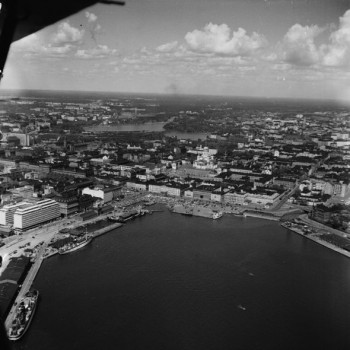
Helsinki harbour: aerial photo from the German Quick magazine, by Volker von Bonin, 1952. The proposed site for the Guggenheim building is bottom left. Photo: Helsinki City Museum
The winner of the Guggenheim Helsinki Design Competition, organised by the Solomon R. Guggenheim Foundation, will be announced in June 2015. ‘An innovative, multidisciplinary museum of art and design’, the winning building, if it will be realised, is likely to be a new ‘architectural dream’.
1,715 submissions were received from 77 countries; a shortlist of six finalists will be announced on 2 December.
In 2012 when the Guggenheim project (see our post from 2012) began to be discussed, the deep ranks of Helsinki taxpayers protested in public by saying that they did not want a costly new monument (building costs 130 million euros) in the city for which it would have been necessary to pay – in addition to maintenance costs – ca. 26 million euros to the American brand for the use of its name during the next 20 years. Finally the City Council voted 8-7 against the mayor’s motion to build the museum.
A comparison: the building costs of an urgently needed new children’s university hospital are 160 million euros: as the state was not able to fully finance the project in the near future, it was decided (in 2013) that 30 million euros would be raised by private sponsors and the general public in order to ensure the beginning of the construction work in 2014. (The goal was reached last August, but the fund-raising campaign will go on to decrease the loan capital, 50 million.) This project has been referred to by the opposers of the Guggenheim project in particular: if the state cannot provide the funds for a national children’s hospital, how could – and why should – it commit itself, albeit with smaller sums, to sponsoring an American art museum in Finland?
No money from the state was promised. No art-minded private sponsors of a future Guggenheim announced themselves in the public either. It turned out, however, that enough private sponsor money was available for an international architecture competition: in 2013 a tentative, central site for a future Guggenheim building was reserved for the competition project, for two years, in Helsinki harbour.
Since that, a group of independent arts organisations has issued a call for submissions for alternative ideas: ‘The next Helsinki’: a new competition aims at bringing forth projects that ‘attach artistry to all aspects of everyday urbanism’, and it is open to all, not just ‘starchitects’, ‘…because the solution is not simply an urban designer’s or artist’s task.’ Deadline is 2 March, 2015.
The organisations taking part are Checkpoint Helsinki, G.U.L.F. (Global Ultra Luxury Faction), Occupy Museums and Terreform, New York. ‘The next Helsinki’ states: ‘The Guggenheim Foundation has launched a design competition on one of Helsinki’s most valuable and compelling physical sites for a new Guggenheim building, in hopes of a transformation akin to the “miracle” in Spain [Bilbao]. The City of Helsinki is tempted to spend hundreds of millions of municipal euros in return for the benefits of the branding of the city with someone else’s mark. Is this really the best use for the site and tax money?’
It remains to be seen who will be the winners, and what will be won.
Winner of the Nordic Council Literature Prize
6 November 2014 | In the news

Kjell Westö. Photo: Kata Portin
The Nordic Council Literature Prize 2014 went to Kjell Westö and his novel Hägring 38 (‘Mirage 38’, 2013; in Finnish, Kangastus 38). The prize, awarded since 1962 and worth €47,000, was given on 29 October at a ceremony in Stockholm.
Among the 13 nominees was another Finn, the poet Henriikka Tavi with her collection Toivo (‘Hope’, 2011).
The jury said: ‘The Nordic Council Literature Prize goes to the Finnish writer Kjell Westö for the novel Mirage 38, the evocative prose of which breathes life into a critical moment in Finland’s history [the time before the Winter War, 1939–1940] – one that has links to the present day.’ Here, more on Westö and his winning novel.
